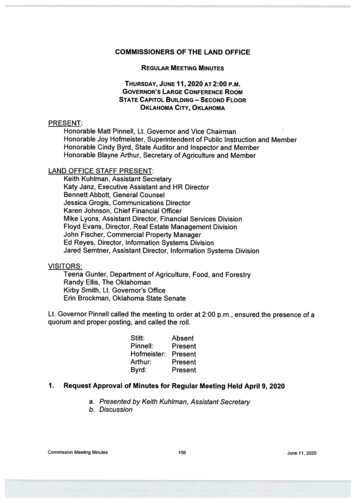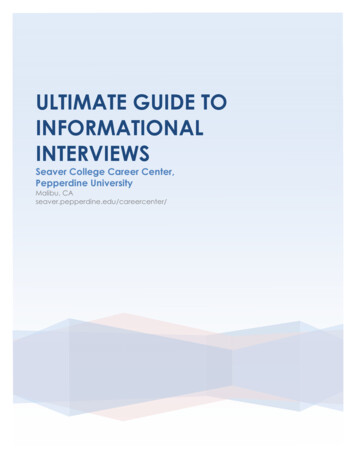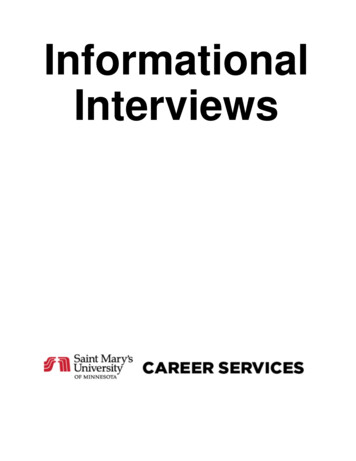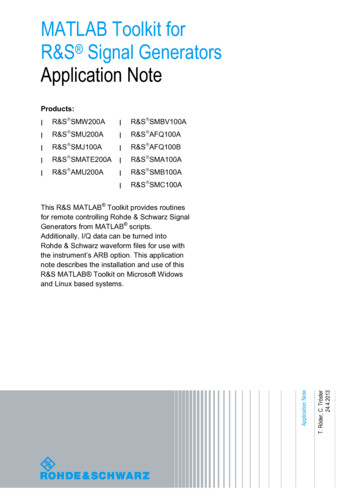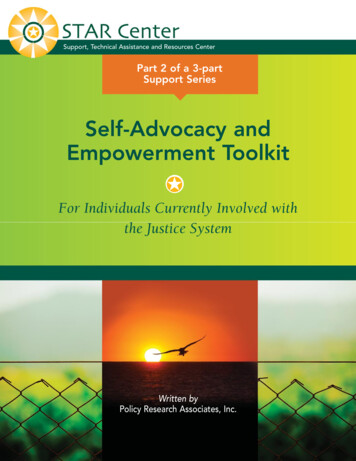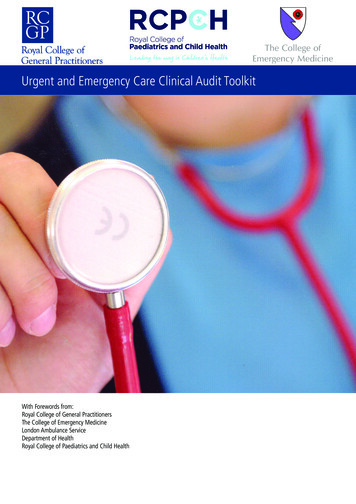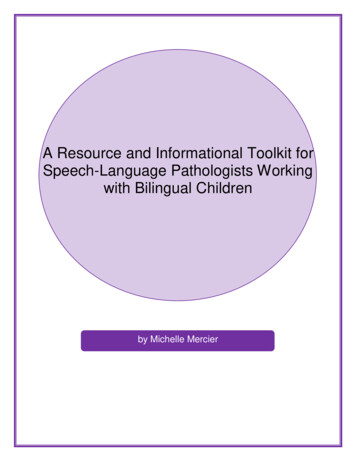
Transcription
A Resource and Informational Toolkit forSpeech-Language Pathologists Workingwith Bilingual Childrenby Michelle Mercier
Table of ContentsIntroduction .3Language Disorder versus Language Difference .4Over- and Under-Identification .5Bilingual Development .6Tips: How to Assess Bilingual Children & Advise Parents .8Myths versus Facts .11Assessment Procedures .13Interpreters and Translators .20Blogs and Websites 22French-English Specific Resources .25French Assessment and Intervention Tools. .26Resources for Parents .27Textbooks .29References .312
IntroductionWhat is Bilingualism?“Bilingualism is the ability to communicate in more than onelanguage and can be thought of as a continuum of languageskills in which proficiency in any of the languages used mayfluctuate over time and across social settings, conversationalpartners, and topics, among other variables” (Grosjean,1989;Bialystok, 2001; on ASHA.org).Why is it Important to SLPs?The number of bilingual children is continuing to grow. As aresult, the caseloads of SLPs are likely to contain a greaternumber of bilinguals (Hoff, 2015). Bilingual children present withunique challenges for both monolingual and bilingual cliniciansalike, as it will be likely that the clinician may not have the client’sL1 or dominant language in common. It will also be a challengefor the SLP because it is their duty to differentiate between alanguage disorder and perceived difficulties as a result of alanguage difference (De Lamo White & Jin, 2011).INTRODUCTION VIDEO: Bilingualism and Speech Language PathologyAn interview with Dr. Kathryn Kohnert where she discusses the importance ofbilingualism in the field of Speech-Language Pathology.https://www.youtube.com/watch?v KxnN6Ig4bqc3
Language Disorder vs. Language DifferenceInformation obtained from: (Prezas & Jo, 2016; Fairchild, 2017; Schmiesing Christians, et al., 2012)To prevent over- or under-identification of Developmental Language Disorders (DLD) inbilingual children, first and foremost, we must understand the distinction between them:Language Difference:Language Disorder:Characterized by atypical receptive and/orexpressive language skills, compared tosame aged peers.Due to distinct or different variations of alanguage, a language difference is the result ofthe normal process of the acquisition of anotherlanguage. It may appear as a delay (not disorder)in the second language however their skills intheir first language are considered ualchildren)VIDEO: Bilingualism &DLDhttps://www.youtube.com/watch?v g7Sj uRV7S4Childrenwith DLDIMPORTANT: This does not mean that a bilingual child cannot have DLD.The signs of DLD will look the same in a bilingual child. Except, for bilingual children the difficulties will be present in ALL of the child’s languages.Learning the second language is not the cause of the disorder.The SLP should be sure to get an accurate picture in their first and second language.You may also want to consult the child’s parents and teacher to see if there are concerns athome and/or in the classroom.TEXTBOOK:Difference or Disorder? Understanding Speech and Language Patterns in Culturally andLinguistically Diverse nguage-patterns/4
Query a Developmental Language Disorder in aBilingual Child?Consider if you may be Over- or Under-identifyingthe child:Over-identification often occurs when: A bilingual child scores below the average range on astandardized test This often occurs on a test normed for monolingual children The SLP will interpret the scores without considering that theyrepresent the child’s knowledge in ONE language and thereforeit does not account for the sum of their profile and knowledge ofBOTH languagesUnder-identification often occurs when: A bilingual child scores below average in comparison to theirmonolingual peers The SLP will over compensate for their dual languageknowledge Therefore the SLP fails to identify a child who does in fact havea language disorder and not just a language differenceTO AVOID THIS ISSUE: GO TO PAGES 14-19 for TIPS REGARDING ASSESSMENT OFBILIINGUAL CHILDRENHoff, E. & Core, C. (2015). What clinicians need to know about bilingualdevelopment. Seminars in Speech Language Pathology, 36(2), 89-99.5
Bilingual DevelopmentInformation obtained from: (Paradis, 2010; Paul, Norbury & Gosse, 2017)(2010)&All Paradisbilingualchildrenlearn 2 different languages however, there are differences in their:-exposure patterns to both languages and-the social contexts in which they are learning the languagesWHICH affects their developmentSimultaneous Bilinguals:Children who acquire bothlanguages at the same time,typically before the age of 3,often from birth.Sequential Bilinguals:Children who learn a secondlanguage after the firstlanguage has already beenfairly established, it is oftenintroduced after the age of 3.Other common terms in the literature: Dual Language Learner: individuals who are learning two languages concurrentlyfrom infancy OR are learning a second language after their first language English Language Learner: language minority students who are learning Englishbecause it is the majority language in the country they reside, for social integrationand educational purposesVIDEO: Bilingual Language DevelopmentWatch Dr. Kathryn Kohnert’s video on bilingual developmenthttps://www.youtube.com/watch?v SNRqJo9niFY6
Common Circumstances During SecondLanguage AcquisitionInterference/Transfer This occurs when errors made in the child’s L2 are due to the influence(interference/transfer) of a structure that occurs in the child’s L1. For ELLs, structures in their L1 may interfere or transfer during their acquisition of L2. For children who are simultaneous bilinguals, there may be evidence of transferbetween their two languages. These situations do not indicate a disorder.Silent Period A silent period may occur when a child is in the beginning stages of acquiring a secondlanguage. This may occur because the child is concentrating on being an activelistener. A common feature: is after some exposure to the L2 the child may initially have betterreceptive than expressive language skills in this language. The younger the child, the longer this period tends to last.Codeswitching Codeswitching refers to when bilingual individuals change languages throughoutphrases or sentences. This is a typical occurrence in many fluent bilingual speakers.Language Loss/Attrition As children begin to learn a second language, if their L1 is not reinforced, it is possiblethat they will begin to lose some of their skills and proficiency in their L1- also known assubtractive bilingualism.Information was obtained from:ASHA (2012) d 8589935225§ion Key IssuesRoseberry McKibbin & Brice nt/easl.htmVisit these links for more information7
TIPS: How to Assess Bilingual Children &Advise ParentsAccording to Hoff & Core (2015), evidence-based literature supports thefollowing conclusions to help clinicians assess bilingual children and offersuggestions to their parents:1: Learning two languages at home does NOT createconfusion nor does it cause a language disorder in the child Children are able to learn two languages at once Infants are able to distinguish one language from another When exposed to two languages, they are able to develop two separatephonological, lexical and grammatical systems Codeswitching is common, it does not mean the child cannot distinguishbetween the two languages The total vocabulary growth for bilingual children is either similar orexceeds that of monolingual children2: The two languages of bilingual children do not need to bekept separate The “one-parent, one-language” is NOT the best principle, it lacksevidence However, some evidence suggests that within utterance mixing forinfants may result in smaller vocabularies3: Learning two languages takes longer than learning one It is normal for children learning two languages to be slower in theirdevelopment of each language compared to monolinguals in theirdevelopment of one language They are often slightly behind in each language in terms of theirvocabulary and grammatical development but are similar to their peersin their phonological and narrative skills Note: although acquiring two languages does take longer than onelanguage, it does not take double the amount of time It also takes a while to be able to catch up to their single language peers8
4: A dominant language in bilingual children is not the sameas only learning one language Many bilingual children are often more proficient in one of their twolanguages Those who have a dominant language will often score within the normalrange of their monolingual peers in that language HOWEVER, they are still not performing precisely as they would if theywere only exposed to and acquiring one languageo Therefore, as an SLP, remember that assessing that child in theirdominant language is NOT the same as assessing a monolingualchild in their only language5: A measure of total vocabulary is the best indicator ofyoung bilingual children’s language learning capacity Bilingual children’s learning abilities are best assessed by taking intoaccount their knowledge in both of their languages Two dual language-based indicators have been suggested (both basedon MacArthur-Bates Inventory):o Conceptual Vocabulary: yields a measure of the number ofconcepts for which the child has in either language, by adding theindividual language scores together and then subtracting the itemsthe child has words for in both languageso Total Vocabulary: appears to be the stronger measure; itindicates what children have learned in both languages, thereforethe proportional input in each language is not important and itallows for monolingual norms to be used6: Bilingual children may have differing strengths in eachlanguage Bilingual children can have different experiences in their two languageswhich may produce varying patterns of proficiency in each language During the development of assessment and treatment goals, SLPsshould consider that bilingual children may have knowledge of wordsassociated with school items in one language (most likely English) andthen home items in their native/home language9
7: Quantity and quality of the input in each language willimpact the child’s rate of development in each language Children’s rate of development is quicker in the language they hearmore often BUT, the quality of the input is equally as important. For example:diverse vocabulary, complex and different syntax and decontextualizedspeech are all important predictors of language growth Input from native speakers is more supportive of language developmentthan input from nonnative speakers8: Parents should NOT be discouraged from speaking theirnative language to their children If parents have acquired English later in life, speaking in English to theirchild may have less benefit to the child’s English skills than anticipated Also by speaking strictly in English to their children, they are deprivingtheir children from learning the language of their cultural background Therefore, rather than encouraging parents to speak only in English totheir children as they learn their second language, SLPs shouldencourage that they also speak their native language and advocate forthe importance and benefits of bilingualism The optimal environment for English language development exposurethat includes rich and highly variable grammatical structures provided bynative English speakers9: There is a lot of variation in bilingual homes/environments,they all provide varying levels of support for each language Bilingual children are immensely varied in the nature of their duallanguage skills This is in part due to the nature of the diversity in which childrenexperience both languageso Homes will differ in the balance of the exposure to each language,which speakers use a particular language and how often. Familystructure variables may also have an impacto SLPs will want to gather information through a thorough casehistory to discover the proportion and support for each language inthe homeHoff, E. & Core, C. (2015). What clinicians need to know about bilingualdevelopment. Seminars in Speech Language Pathology, 36(2), 89-99.10
Resources with Bilingual Myths versus Facts:Click Here toView this Image& It's Blog Post11
More Resources: Myths about BilingualismWEBSITE: To see othermyths about ngFact-fr.aspxVIDEO: Myths AboutBilingual ChildrenBrenda Gorman discussesthe myths of bilingualismin children.https://www.youtube.com/watch?v LVYhpCprtzQJOURNAL ARTICLE:Genesee, F. (2015). Mythsabout early childhoodbilingualism. CanadianPsychology/Psychologiecanadienne, 56(1), 6-15.Click Here12
Assessment of Bilingual ChildrenThe main assessment challenge, as discussed earlier is: Distinguishing language disorder versus languagedifferenceCONSIDER!These Red Flagsfor SpeechImpairmentIn BilingualChildrenClick HereBE SURE TO: have an understanding of bilingual development, review thestudent’s OSR, conduct a case-history, perform a classroom observation,speak with the family and teacher to determine language exposure andusage, consult bilingual SLPs and consider both languages during AXClick Here for: Language History Questionnaires in different languagesClick Here for: The Alberta Language Development Questionnaire (they are intended tobe given to parents as an interview to ensure they understand the questions)Click Here for: The Intelligibility in Context Scale (a quick parent report regarding theparent’s perception of the child’s intelligibility)Click Here for: The Language Experience and Proficiency Questionnaire (LEAP-Q), it isavailable in many languagesAn important part of the assessment is to have knowledge of the family’sculture and language use, this includes the dialectal variation they use Without this consideration, the clinician risks conducting anassessment that is biased towards the child’s linguistic and culturalbackground and it may not paint a true picture of their communicativeabilities The socio-cultural approach should be used- it provides a holisticview of the child’s speech and language skills within their social andcultural environment Note: The child should be assessed in ALL/BOTH languages theyspeak, if necessary the SLP can use an interpreter or translator. (Seepages 20-21).13
WHICH ASSESSMENT PROCEDURES SHOULD WE USE FORBILINGUAL CHILDREN?USE WITHCAUTIONNorm-Referenced Standardized Measures Considered the gold standard to be able to identify a languagedisorder BUT they are often inadequate for bilingualchildren due to:o Content biaso Linguistic biaso Small sample of bilingual children innorms Should not be formally scored and comparedto monolingual norms, but can still provideuseful informationTIP!Chapter 5 in Paul &Norbury (2012)’s textbookcontains excellentinformation ANDAppendix 5-2 containssamples of AX materials Note: Even when English tests are adapted to other languages, theyoften do not consider DLD markers for the target language and theywill often not be accurate for identification purposes Paul and Norbury (2012), p. 154 Box 5-9, suggests ways to modifystandardized tests for the assessment of children with linguistic andcultural differences (CLD) Criterion-Referenced (CR) Measures This method allows for measurement of a child’s knowledge andlevel of performance in a particular domain CR measures are usually informal, they often include languagesampling and probing They allow the SLP to use materials which are familiar to the child,thus they are able to reduce some of the linguistic and cultural bias These measures can be used when standardized tests areunavailable or if they are considered inappropriate, which often holdstrue for bilingual children To use these measures be sure to supplement with backgroundinformation from the family (aka. use the sociocultural approach!) Use in combination with other measures such as LP and DA14
Language-Processing Measures These tasks are independent of the child’s knowledge and arebelieved to be less biased because they do not depend onlinguistically or culturally determined information (e.g. vocabulary) These tasks utilize the processes that are involved in languagelearning. They are also quick to administero They include tasks such as:- Digit span-Competing language processing tasks-Working memory-Perceptual tasks (such as Revised Token Test)-Non-word repetition These are good measures BUT should not be used alone foridentification of DLDDynamic Assessment The goal of this measure is to determine the potential for learning Test, teach, retesto This method provides information about current levels ofperformance, the potential effects of intervention and givesinsight as to which strategies are most helpful to support furtherlearningo It examines modifiability which is how much effort is required bythe clinician for the child to be successful and how much thechild will transfer the learningo Children with DLD will most likely show lower modifiability andlittle transfer of the learning Therefore, children who are able to make changes between the testand retest periods are likely to have language differences and notdisorders Note: it can be time consuming and this may pose difficulties in theschool board setting, therefore this method should be discussed todetermine how it is possible with the resources available15
Table 5-4 Taken from Paul and Norbury (2012)’s Textbook Page 152:“A Model for Comprehensive Assessment of English LanguageLearners”Type of AssessmentDevelopmental HistoryInformation ProvidedHistory of language acquisitionSchool HistoryMedical history that could affectspeech and languageHistory of schoolingLanguage Use HistoryDynamic AssessmentLanguage SamplingBehaviouralObservationNorm ReferencedAssessmentHistory of supports for 2ndlanguage acquisitionUse of primary and secondarylanguage at home with parents,siblings, extended family andfriendsLanguage preferences in differentsettings or for different activitiesAbility of the child to learn newtasks in a structured teachingenvironmentChild’s connected speech in lessstructured tasks such as:MLUNarrative StructurePragmatic Language SkillsConnected speech in social vsacademic settingsPragmatic language patternsLanguage preferencesQuantitative comparison of thechild’s language skills to TD peersSourceParentsParents, teachers, schoolrecordsParents, studentsTest, teach, testprocedures with studentStory telling or retellingConversationClassroom conversationsand cooperative learningwith peersIndividually administeredtest16
Useful Resource:ASHA’s Multimedia tutorial on the use of dynamic assessments for children withlinguistically diverse ral/issues/Dynamic-Assessment/Article about DA:Kapantzoglou, M., Restrepo, M. A., & Thompson, M. S. (2012). DynamicAssessment of Word Learning: Identifying Language Impairment in BilingualChildren. Language, Speech and Hearing Services in Schools, 43, 81-96.VIDEO: Dynamic AssessmentThis video displays how in 4 steps DA can help determine the amount of support a childneeds for therapy.https://www.youtube.com/watch?v YKHQTrd-5FE&feature youtu.beVIDEO: Key Components of Bilingual Language AssessmentBrenda Gorman discusses the 4 components of a bilingual assessment, andrecommends the Ronald B. Gilliam’s Language Assessment Model.https://www.youtube.com/watch?v Ssz cutETTE17
Information for this section was obtained from the following articles:De Lamo White, C., & Jin, L. (2011). Evaluation of speech and language assessment approacheswith bilingual children. International Journal of Language & Communication Disorders,46(6), 613-627.Arias, G. & Friberg, G. (2017). Bilingual Language Assessment: Contemporary VersusRecommended Practice in American Schools. Language, Speech, and Hearing Services inSchools, 48, 1-15.Goldstein, B. & Kohnert, K. (2005). Speech, Language, and Hearing in Developing BilingualChildren: Current Findings and Future Directions. Language, Speech & Hearing Services inSchools, 36, 264-267.Paradis, J., Schneider, P. & Sorenson Duncan, T. (2013). Discriminating children withlanguage impairment among English-language learners from diverse first-languageback grounds. Journal of Speech, Language, and Hearing Research, 56(3), 971-982.Assessment Considerations of English Language Learners:*As per Lisa Archibald’s DLD 2 Quick Guide Reference-understand exposure & use of the child’s both languages-consider the cultural differences involved in test taking and social interactions-compare processing tasks to knowledge tasks-consider the sum of knowledge across both/all languages (ex. total vocab)-dynamic assessment may reveal learning potential-be cautious with the use of interpreter/ translators: translated English tests arenot the same as tests devised for the target language and you may not beaware of cues being provided by the interpreter/translator18
More Resources You May Also Want to lp/ Article: Tips for Assessing Bilingual Children as a Monolingual tispecialty/speechlanguage/bilingualism A brief explanation of bilingualism and x?folderid 8589935225§ion Overview “Bilingual Service Delivery” on ASHA’s special speech/speech-assessments Contains a list of various assessment test batteries available inother languagesBedore, L. M. & Pena, E. D. (2008). Assessment of bilingual children foridentification of language impairment: current findings andimplications for practice. International Journal of Bilingual Educationand Bilingualism, 11(1), 1-29.19
Interpreters and Translators:The child should be assessed in BOTH languages, therefore when a bilingual speechlanguage pathologist (SLP) is not available, using an interpreter/translator is an optionbut they should be used with caution:Why might we need interpreters and translators? Legal and ethical standards require that:o services to individuals who use a language other than Englishmust be delivered in the language most appropriate for theclient/patient Often the number of languages used and the number of individualswho require services in a language other than spoken English ISMORE THAN bilingual service providers can provide Therefore, it may be necessary for the clinician to collaborate with aninterpreter or translator to ensure appropriate servicesWhen to use interpreters/translators? Interpreters are often required when the client/patient and themembers are unable to communicate using the same language Translators function similarly however they are interpreters for writtenlanguageWhat are they used for? A professional interpreter may be used to observe the patient, tounderstand the content of what is being expressed and thenparaphrase the message provided by the client/patient using thetarget language They are independent, aware of confidentiality and can aid withculturally-specific topics and questionsWho can be used as an interpreter? When members communicate in a different language from thepatient, members are responsible for using the most appropriatemethods of interpretation to provide serviceFor the purpose of ensuring objectivity, members should useprofessional interpreters20
The use of family members or friends to interpret is notoptimal, but at times might be the only option for the memberto overcome the communication barriero The member should train the family to interpret only what themember and the patient sayThe member should always remain alert to the patient’s verbal andnon-verbal communication to help determine their understandingas information is being interpretedThe member should also be aware of the cultural differences innon-verbal communicationo How to choose an interpreter?Someone who has: A level of proficiency in spoken English and in the language/dialectused by the client/patient/family,prior experience,educational background and/or professional training,certificationVisit the links below for more information:ASHA’s Collaborating with .aspx?folderid 8589935334§ion OverviewCASLPO’s Service Delivery to Culturally Diverse /files/GU EN Service Delivery to%20Culturally Diverse Populations OCT 2015.pdf21
Useful Blogs and centre This website contains resources from the Child English as a Second LanguageResource Centre which is the outcome of a research program that has compiledmany resources to aid SLPs in assessing language development in childrenlearning English as rid 8589935225§ion Key Issues Professional Issues on ASHA’s website regarding Bilingual Service tion/ This specific blog entry is regarding Speech and Language Assessment andIntervention for Bilingual studentshttps://www.beststart.org/resources/hlthy chld dev/BSRC When Families Speak fnl.pdf When Children Speak More than One Language: A resource about bilinguals andlanguage development, developed by a variety of professionals, including twoSLPs for the Best Start Resource Centrehttp://psychologia.pl/clts/#about This website has been developed by a group that is designing cross-linguisticlexical tasks in many languageshttps://bilinguistics.com/bilingual-slp/ Linked is a post about the monolingual bilingual SLPhttp://speechisbeautiful.com A blog ran by a bilingual SLP in the US, she includes English, Bilingual andSpanish resources. She has many good articles about bilingual therapy andassessment22
http://www.elltoolbox.com A website designed primarily for teachers of ELL students, however there aremany great APPS, checklists, and literacy programs that would be useful for eid 2442989 Video and Transcript: Joanne Paradis (2014)- Discriminating Children with DLD(SLI) Among English Language Learnershttps://2languages2worlds.wordpress.com The authors of this blog are either researchers studying bilingualism, bilingualSLPs or studying education. There are a variety of articles that span bilingualismacross the lifespan (school-aged issues are addressed)http://www.botte-boot.com/ 'Bilingualism in Ontario' – this is a website that is maintained by a SpeechLanguage Pathology faculty member at Laurentian. It contains handouts andprintable materials for parents or SLPs. It also contains some presentations andposter slides for different aspects of n-bilingual-children-16524 A blog entry written by an SLP with the focus being on Screening andAssessment of Language in bilingual children. It includes a list of standardizedtests for Spanish speaking lp/ Tips for Assessing Bilingual Children as a Monolingual SLP written by an n-childrens-narratives/ This blog explains the “Cultural Influences in Children’s Narratives”, it provides acomparison between narratives in English and e-in-speech-therapy/ A link with 5 Apps for Bilingual Children to use in Speech Therapy23
If you are a member of ASHA, here are some useful articles surroundingASSESSMENT of bilingual children that you can icleid 2578724 Article: Bilingual Language Assessment: Contemporary Versus RecommendedPractice in American icleid 2597276 Article: Synthesizing Information from Language Samples and StandardizedTests in School-Age Bilingual articleid 1785529 Article: Dynamic Assessment of Word Learning Skills: Identifying LanguageImpairment in Bilingual Children24
Bilingual French-English ascall/ Pascal Lefebvre – a Speech Language Pathology Professor at LaurentianUniversity, posts articles on this website. He is conducting research on languageand literacy for children and on the prevention of reading and writing difficulties.Professor Lefebvre is also involved in the implementation of preventativepractices in elementary schools and early education facilities. He is a goodname to know for the F-E bilingual research.https://sites.ualberta.ca/ jparadis/Johanne Paradis Homepage/Publications.html Dr. Johanne Paradis is a Professor in the Department of Linguistics at theUniversity of Alberta. She does research on the francophone populationdevelopment in terms of bilingual development. The link above is a link to all ofher publications.French Website for SLPs:https://cuitdanslebec.wordpress.com This French website aims to disseminate and summarize the most recentevidence based literature in the field of SLP to make it widely understandable.The
with DLD IMPORTANT: This does not mean that a bilingual child cannot have DLD. The signs of DLD will look the same in a bilingual child. Except, for bilingual children the difficulties will be present in ALL of the child's languages. Learning the second language is not the cause of the disorder.
